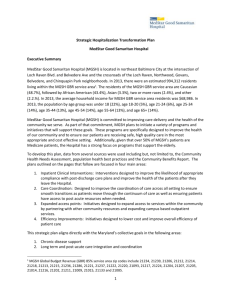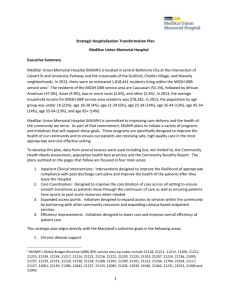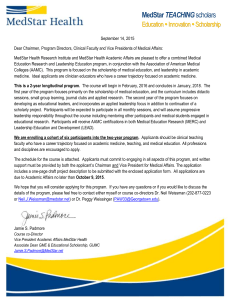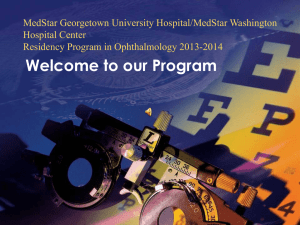Centralizing Patient Access in a System Environment
advertisement
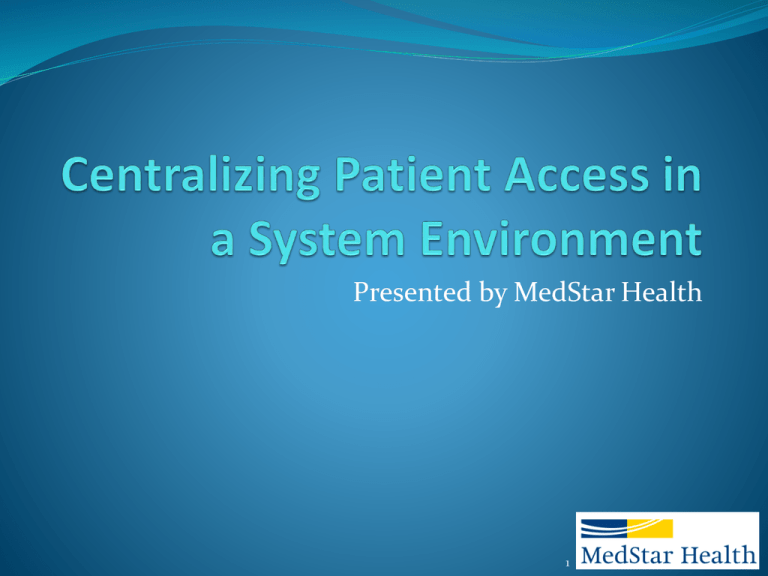
Presented by MedStar Health 1 Presented by: Cathy Foster, Assistant Vice President CPAM, CHAM 2 MedStar Health MedStar Health is a $4.4 billion not-for-profit, regional healthcare system with a network of 10 hospitals and 20 other health-related businesses across Maryland and the Washington, D.C., region. As the area's largest health system, it is one of the region's largest employers with almost 30,000 associates and 5,600 affiliated physicians, all of whom support MedStar Health's patient-first philosophy that combines care, compassion and clinical excellence with an emphasis on customer service. Revenue Cycle Account is referred to the designated vendor for collection The account balance is not paid and the account is sent to bad debt Teamwork Patient makes appointment Ins. Verification/ ID Pt. Deposit/Co-pay Service Services rendered / revenue is recorded Coding: DX and procedure Patient makes payment, or payment arrangements. Once account balance is zero the account is closed SMS- Account qualifies for billing (837) Patient First 837 (UB04) generates Innovation Patient is sent statement(s) for the deductible, co-pay, etc & is sent to the payor: Medicare Caremedic / 3rd Party – Caremedic All Payor System Follow-up on pended and denied claims Denied Claim: Based on the denial: 1) write the balance off, 2) appeal with documentation Payor: pay, pend or deny claim Respect Integrity Pended Claim: Require s follow-up with the payor and or the submission of additional information Paid Claim: (835) Payment is posted, discount applied and patient is billed for any residual portion Who are we? MedStar Union Memorial Hospital – Baltimore, MD MedStar Good Samaritan Hospital – Baltimore, MD MedStar Franklin Square Medical Center – White Marsh, MD MedStar Harbor Hospital – Baltimore, MD MedStar Washington Hospital Center – Washington, DC MedStar Georgetown University Hospital – Washington, DC MedStar National Rehabilitation Network – Washington, DC MedStar Montgomery Medical Center – Olney, MD MedStar St. Mary’s Hospital – Leonardtown, MD MedStar Southern Maryland Hospital Center – Clinton, MD 5 What do we do? Central Financial Clearance for hospital ancillary and surgery and inpatient accounts. Patient Access Training Billing and Cash Posting Collections and Customer Service MedStar Research Compliance and Regulatory Renal Billing Patient Advocacy – Medicaid Eligibility and Financial Assistance SMS-Invision Front and Back End Revenue Cycle Oversight 6 Central Financial Clearance (CFC) Located in White Marsh, MD and Arlington, VA Insurance verification Initiation of authorization Estimating charges Pre-collection activities Demographic verification Current state vs. future state Pre-registration 7 Old Process No interface existed between SMS Invision and PICIS (OR Scheduling System). Facility Patient Access created SMS account during pre-registration.* CFC could not control their workflow as they were dependent upon the account creation. If account was not created timely, could possibly impact reimbursement and ability to obtain authorization. *Pre-registration is defined as speaking to the patient to validate demographics. 8 New Process Interface created between SMS Invision and Cerner SurgiNet Scheduling. Immediate account creation upon scheduling allows for more efficient CFC workflow. Required additional registration training for the facility scheduling staff. Validation of positive patient ID required at time of scheduling to avoid creation of duplicate medical records. CFC and Facility Access Management teams worked together to create the process. 9 New Workflow After Scheduling Central Financial Clearance Via HDX, web or phone 10 If no authorization obtained CFC contacts the facility when authorizations are still outstanding within 48 to 24 hours. Facility/physician decides whether to accept patient without definite authorization. CFC DOES NOT CANCEL SERVICES. 11 Quality Assurance CFC staff are continuously monitored to ensure compliance with registration procedures. Accounts are audited and phone calls are screened. Follow up customer satisfaction phone calls to preregistered patients. Positive and negative feedback provided consistently between CFC and facilities via emails and regular meetings. 12 Teamwork Patient Access and CFC collaborate to assure: The highest quality experience to all MedStar patients Successful reimbursement for the services provided Open communication for consistent performance improvement 13 Presented by: Barbara Blum, Access Director 14 Facts and Figures Located at: 201 East University Parkway, Baltimore, MD 21218 Total licensed beds: 249 Acute care beds: 231 Rehab beds: 18 Annual inpatient admissions: 14,979 Annual outpatient visits: 105,662 Annual Emergency Department visits: 58,837 Associates: 2,416 Affiliated physicians: 623 Total net operating revenue: $427.0 million 15 Our Specialties Hand Center Since 1975, people all over the world have placed their hands in ours - Curtis National Hand Center. Today, the Curtis National Hand Center is recognized as the largest, most experienced hand center in the nation. Heart Institute Last year alone, our doctors performed more than 880 open-heart surgeries and 6,100 catheter-based procedures, including nearly 2,000 angioplasties. No hospital in Maryland or nationally performs a higher percentage (94 percent) of beating-heart bypass surgeries. Orthopaedics and Sports Medicine Nationally-recognized for excellence in orthopaedics and sports medicine, we're home to one of the world's largest hand centers, a comprehensive sports medicine program, and specialists who are fellowship-trained in care of the hand, foot and ankle, joint replacement, spine and sports medicine. 16 Awards and Recognitions Delmarva Foundation Excellence Award for Quality Improvement The only hospital in Maryland to receive the award five years in a row. America Best Hospitals Named one of the nation's top 50 hospitals for diabetes and endocrinology, orthopaedics, heart care and surgery, and geriatric care by U.S. News & World Report. Named among the top three hospitals in Baltimore in U.S. News & World Report's metro area rankings, 2012. Thomson Reuters 100 Top Hospitals®: Cardiovascular Benchmarks for Success Named four times as one of the nation's top 100 heart hospitals by Thomson, a leading source of information products for the healthcare industry. Commission on Cancer Cancer program accreditation 17 Surgery Patient Check-In Patients check in at the centralized outpatient registration area. Patients are tracked through the pre-op Tracking Board. Patient ID and insurance are validated for accuracy. Armband is placed on patient. Final consents and forms signed and explained. Registrar checks Time of Service screen and collects any patient liabilities due. Assure all patients’ questions are answered. 18 Goals of On-Site Patient Access Decrease registration wait times to avoid delays in patient care. Increase Time of Service collections. Assure a positive patient registration and scheduling experience. Accountable for final “quality check” of demographic and insurance data. Admissions representatives are “partners” with CFC in the patient arrival and clearance process. 19 May 2013 Presented by Louanne Diano-Zayas Director, CSVU, CFC and Cashier’s Office MedStar Washington Hospital Center About MWHC Licensed 926 beds 41,127 Inpatients/year 9,853 Cardiac Caths/year 1624 Open Heart Surgeries/year 68,677 Emergency Dept Visits/year 409,517 Outpatient Visits/year 2,587 MedSTAR Trauma Visits/year Alliance with the Cleveland Clinic 21 Why did we Implement GECB? To Centralize and Standardize scheduling in a single System Inconsistent Policies and Procedures followed to gather information for scheduling appointment (ex. demographics, insurance, etc.) Inconsistent scheduling practices Depts using Appointment Books Depts using Multiple Scheduling Systems – Resource Scheduling, EMR, ARIA To enhance the Professional Billing process and enter charges into a single system Professional Charge Entry was done manually To Collect real time Professional Time of Service Payments Physician Time of Service was a manual transfer process 22 Why did we Implement GECB? To Enhance Patient through-put Unable to view patient appointments for other departments To Integrate with our Electronic Medical Record To Centralize scanning in one system To Standardize with Corporate Scheduling & Registration systems 23 How we Did it? Piloted 2 Departments – ENT and EYE Center Used a Phased approach based on Specialty Average of 3 months implementation for Departments Trained over 350 Associates (4 day training) Manual Appointment Conversion Team Approach to Conversion Department Management and Associates Training and Education Departments Consultants GECB, INVISION and other IT Representatives Created Standardized Policies and Procedures Complete Implementation took approximately 1 1/2Year 24 Outcomes Created a ONE-STOP process for patients for scheduling, arrival and professional charge entry and TOS collections Centralized and Standardized scheduling in a single System Enhanced the Professional Billing and Time of Service Collections process Standardized policies and procedures Reduction in Scanning – Single Repository for Data Improved Patient Satisfaction 25 Presented by: Carrie Long, Training Manager CHAM 26 Training Department Four team members. Trains Patient Access registration procedures and processes. Six hospitals and two business offices located throughout Baltimore and DC. 27 New Hire Training Three full days, twice a month. Presentation, hands-on practice in Test system, in- class activities, competency tests. Topics covered: Registration system (Siemens Invision) Patient Search and Duplicate Medical Record All major payors; Medicare and MSP, Medicaid, Blue Cross, Managed Care, etc. Integrated eligibility system (Siemens HDX) 28 Refresher Training Monthly sessions Conducted In-Class and by Webinar At the facilities and business offices Topics include: Medicare MSP Medicaid Managed Care 29 System Changes Obtain agreement from all Access Directors. Change goes into Test system. Training team and each Access Director will test the new change. Once all agree that change is functioning appropriately, it will be moved into Production. Training Team sends out educational notice to all facilities. 30 Training New Systems Trained all surgery schedulers: How to conduct a proper patient search How to create a new registration How to select the appropriate insurance plan Training Team was on-site for the week of go-live. Maintain constant communication and feedback with each scheduling office. Administered competency test several weeks after golive. 31 Training Website 32 Webinar Comments I thought this was a super professional job. You should all be proud of this work. The Webinar was very well organized and easy to follow. Thank you. The presenter did a great job with the Webinar. She made the information very comprehendible. I will definitely attend another Webinar in the future...Kudos to Amy Gair!!! I have a better understanding of how Medicare coverage works, especially the ESRD which I was not very comfortable with. Thank you Ladies. 33 Monthly Newsletter 34 See you at the races! YUM!! 35
